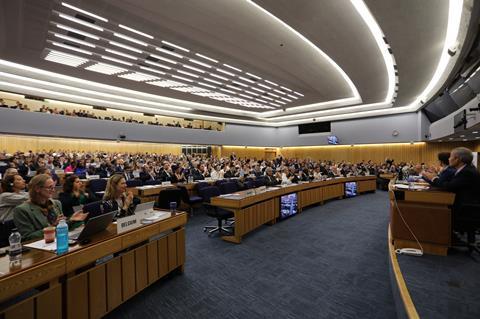While the IMO put forward its revised strategy to reduce greenhouse gas (GHG) emissions from international shipping as ‘enhanced targets’, others have criticised the Marine Environment Protection Committee (MEPC 80) for its failure to align global shipping with Paris Agreement’s 1.5°C temperature-warming limit.

The strategy adopted by the IMO includes a goal to reach net-zero GHG emissions from international shipping “close to 2050”. Checkpoints along the way include GHG reductions of at least 20 percent (striving for 30 percent) by 2030 compared to 2008 levels, and at least 70 percent (striving for 80 percent) by 2040, as HLPFI reported here.
According to the Clean Shipping Alliance, while this brings shipping closer to the Paris Agreement’s temperature goal than before, it is far from sufficient to ensure shipping contributes its fair share.
John Maggs, Clean Shipping Coalition president, said: “There is no excuse for this wish and a prayer agreement. They knew what the science required, and that a 50 percent cut in emissions by 2030 was both possible and affordable. Instead, the level of ambition agreed is far short of what is needed to be sure of keeping global heating below 1.5ºC and the language seemingly contrived to be vague and non-committal.”
The Clean Shipping Coalition said that new regulations must be introduced, and existing ones tightened, to bring emissions down as soon as possible. This includes incentives to roll-out wind technologies, green fuel mandates to drive the uptake of zero-emission solutions, action on short-term climate pollutants such as methane and black carbon, mandatory slow-steaming, and the inclusion of shipping in national carbon markets.
The EU’s emissions trading scheme (ETS) and the UK’s emission trading for shipping, as well as the EU’s marine fuels standard (FuelEU Maritime), set examples for other countries and regions to follow, it added.
Other initiatives, according to the Clean Shipping Council, include global and regional shipping levies, on a 1.5°C-aligned basis and of at least USD100 per tonne of GHG, are essential for generating vital climate finance to support vulnerable countries and ensure an equitable transition in the industry.
It said that the shipping industry has made clear a 1.5°C-aligned transition is achievable, and it must increase its efforts to meet this target in the absence of IMO’s leadership.
Putting it bluntly, Faig Abbasov from Transport & Environment (T&E) said: “Aside from FIFA, it’s hard to think of an international organisation more useless than the IMO. This week’s climate talks were reminiscent of rearranging the deckchairs on a sinking ship. The IMO had the opportunity to set an unambiguous and clear course towards the 1.5ºC temperature goal, but all it came up with is a wishy-washy compromise. Fortunately, states like the US, UK and the EU don’t have to wait for China, Brazil and Saudi Arabia to act. Ambitious national policies and green shipping lanes can have a global impact. It’s time to think globally, act locally.”
















